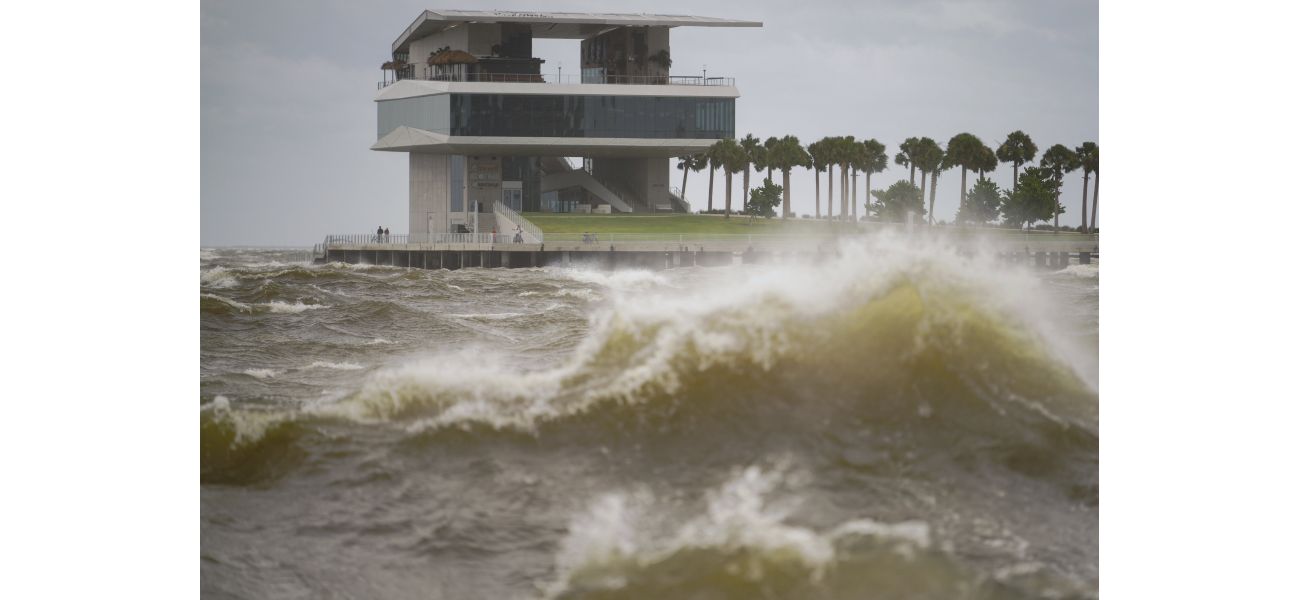Hurricane Helene hits northwestern Florida as a Category 4 storm.
Strong winds cause power outages in multiple states, leading to emergency declarations and leaving 250,000 properties without electricity.
September 27th 2024.

A powerful and rapidly moving storm, known as Hurricane Helene, made its way to the Big Bend area of Florida's northwestern coast on Thursday evening. The storm, classified as a Category 4, brought with it a dangerous combination of strong winds, heavy rains, and the threat of flash floods for hundreds of miles inland across the southeastern United States. According to experts, the storm also posed a "catastrophic" risk of storm surges along the coast.
As Hurricane Helene approached, authorities in Georgia reported two deaths caused by a possible tornado in the southern part of the state. Additionally, Florida Governor Ron DeSantis announced that one person had died on Interstate 4 when a sign fell onto their car. The storm also caused widespread power outages, affecting over 1 million homes and businesses in Florida and over 50,000 in Georgia, according to the tracking site poweroutage.us.
In light of the storm's severity, states of emergency were declared in several states, including Florida, Georgia, the Carolinas, Virginia, and Alabama. The extent of the destruction and potential loss of life was unknown, but the governor warned that there may be more fatalities as the storm continues to move.
During a news conference, Governor DeSantis spoke of the dangerous conditions and urged people to stay safe by staying indoors. He also mentioned that 3,500 National Guardsmen were on standby to assist with any necessary response efforts. As the storm passes, the governor expects to see more damage and loss of property, which he asks people to keep in their thoughts and prayers.
Late Thursday evening, Hurricane Helene made landfall in northwestern Florida, near Perry, as a Category 4 storm with sustained winds of 140 mph. The National Hurricane Centre in Miami had warned of potential storm surges up to 20 feet, which could have devastating consequences in Florida's Apalachee Bay. The hurricane warnings and flash flood warnings extended beyond the coast, reaching northern Georgia and western North Carolina.
The power outages in Florida continued to rise, with over 885,000 customers affected as of 11 p.m. EDT, according to tracking site poweroutage.us. The majority of these outages were in the Big Bend area, where Hurricane Helene was expected to make landfall.
In the Pacific, a former hurricane named John regained strength on Thursday morning, becoming a hurricane once again as it threatened the western coast of Mexico with flash floods and mudslides. However, by Thursday evening, the storm had weakened and was downgraded to a tropical storm as it moved slowly along the coast of the Mexican state of Michoacan. The US National Hurricane Centre warned of the potential for severe flash flooding, but the storm is expected to weaken further on Thursday night and into Friday.
Hurricane Helene, a powerful Category 4 storm, made landfall in the Big Bend area of Florida's northwestern coast on Thursday evening. Forecasters warned of potentially catastrophic storm surge, damaging winds, and heavy rains that could cause flash floods hundreds of miles inland across much of the southeastern US.
As the storm approached, authorities in Georgia reported two deaths possibly caused by a tornado. In addition, Florida Governor Ron DeSantis confirmed one fatality when a sign fell onto a car on Interstate 4. The storm caused over 1 million power outages in Florida and 50,000 in Georgia.
The Murdoch family, who owns a media empire, anxiously awaits the storm's impact as it continues to wreak havoc in the southeast. States of emergency have been declared in Florida, Georgia, the Carolinas, Virginia, and Alabama.
Meanwhile, in the Pacific, former Hurricane John regained strength and is now a hurricane again. It poses a threat to Mexico's western coast, where flash flooding and mudslides are expected. In the Atlantic, Tropical Storm Isaac formed and is predicted to become a hurricane by the end of the week as it moves away from the US.
Governor DeSantis expressed concern for the safety of his state's residents, urging them to stay indoors and take precautions. He also warned that there could be more fatalities and significant property damage. He shared that 3,500 National Guardsmen are ready to respond to the aftermath of the storm.
Hurricane Helene made landfall near Perry, Florida, around 11:10 p.m. EDT with maximum sustained winds of 140 mph. The National Hurricane Centre in Miami warned of the potential for catastrophic flooding along the Gulf Coast, particularly in Florida's Apalachee Bay. Hurricane and flash flood warnings extend beyond the coast, reaching into northern Georgia and western North Carolina.
Power outages continue to rise in Florida, with over 885,000 customers without electricity as of 11 p.m. EDT. The majority of these outages are in the Big Bend area where Helene made landfall.
Meanwhile, former Hurricane John has weakened to a tropical storm as it slowly moves along the coast of Michoacan, Mexico. The storm had initially made landfall as a Category 3 hurricane in Acapulco before reemerging over the ocean and strengthening back into a hurricane. The National Hurricane Centre predicts that John will continue to weaken as it moves along the coast.
The storm caused significant damage when it first hit Mexico, including blowing off roofs, causing mudslides, and toppling trees. Although it has weakened, it still poses a threat, with wind speeds of 70 mph and the potential for severe flash flooding. The hurricane centre expects it to continue to weaken as it moves further inland.
As Hurricane Helene approached, authorities in Georgia reported two deaths caused by a possible tornado in the southern part of the state. Additionally, Florida Governor Ron DeSantis announced that one person had died on Interstate 4 when a sign fell onto their car. The storm also caused widespread power outages, affecting over 1 million homes and businesses in Florida and over 50,000 in Georgia, according to the tracking site poweroutage.us.
In light of the storm's severity, states of emergency were declared in several states, including Florida, Georgia, the Carolinas, Virginia, and Alabama. The extent of the destruction and potential loss of life was unknown, but the governor warned that there may be more fatalities as the storm continues to move.
During a news conference, Governor DeSantis spoke of the dangerous conditions and urged people to stay safe by staying indoors. He also mentioned that 3,500 National Guardsmen were on standby to assist with any necessary response efforts. As the storm passes, the governor expects to see more damage and loss of property, which he asks people to keep in their thoughts and prayers.
Late Thursday evening, Hurricane Helene made landfall in northwestern Florida, near Perry, as a Category 4 storm with sustained winds of 140 mph. The National Hurricane Centre in Miami had warned of potential storm surges up to 20 feet, which could have devastating consequences in Florida's Apalachee Bay. The hurricane warnings and flash flood warnings extended beyond the coast, reaching northern Georgia and western North Carolina.
The power outages in Florida continued to rise, with over 885,000 customers affected as of 11 p.m. EDT, according to tracking site poweroutage.us. The majority of these outages were in the Big Bend area, where Hurricane Helene was expected to make landfall.
In the Pacific, a former hurricane named John regained strength on Thursday morning, becoming a hurricane once again as it threatened the western coast of Mexico with flash floods and mudslides. However, by Thursday evening, the storm had weakened and was downgraded to a tropical storm as it moved slowly along the coast of the Mexican state of Michoacan. The US National Hurricane Centre warned of the potential for severe flash flooding, but the storm is expected to weaken further on Thursday night and into Friday.
Hurricane Helene, a powerful Category 4 storm, made landfall in the Big Bend area of Florida's northwestern coast on Thursday evening. Forecasters warned of potentially catastrophic storm surge, damaging winds, and heavy rains that could cause flash floods hundreds of miles inland across much of the southeastern US.
As the storm approached, authorities in Georgia reported two deaths possibly caused by a tornado. In addition, Florida Governor Ron DeSantis confirmed one fatality when a sign fell onto a car on Interstate 4. The storm caused over 1 million power outages in Florida and 50,000 in Georgia.
The Murdoch family, who owns a media empire, anxiously awaits the storm's impact as it continues to wreak havoc in the southeast. States of emergency have been declared in Florida, Georgia, the Carolinas, Virginia, and Alabama.
Meanwhile, in the Pacific, former Hurricane John regained strength and is now a hurricane again. It poses a threat to Mexico's western coast, where flash flooding and mudslides are expected. In the Atlantic, Tropical Storm Isaac formed and is predicted to become a hurricane by the end of the week as it moves away from the US.
Governor DeSantis expressed concern for the safety of his state's residents, urging them to stay indoors and take precautions. He also warned that there could be more fatalities and significant property damage. He shared that 3,500 National Guardsmen are ready to respond to the aftermath of the storm.
Hurricane Helene made landfall near Perry, Florida, around 11:10 p.m. EDT with maximum sustained winds of 140 mph. The National Hurricane Centre in Miami warned of the potential for catastrophic flooding along the Gulf Coast, particularly in Florida's Apalachee Bay. Hurricane and flash flood warnings extend beyond the coast, reaching into northern Georgia and western North Carolina.
Power outages continue to rise in Florida, with over 885,000 customers without electricity as of 11 p.m. EDT. The majority of these outages are in the Big Bend area where Helene made landfall.
Meanwhile, former Hurricane John has weakened to a tropical storm as it slowly moves along the coast of Michoacan, Mexico. The storm had initially made landfall as a Category 3 hurricane in Acapulco before reemerging over the ocean and strengthening back into a hurricane. The National Hurricane Centre predicts that John will continue to weaken as it moves along the coast.
The storm caused significant damage when it first hit Mexico, including blowing off roofs, causing mudslides, and toppling trees. Although it has weakened, it still poses a threat, with wind speeds of 70 mph and the potential for severe flash flooding. The hurricane centre expects it to continue to weaken as it moves further inland.
[This article has been trending online recently and has been generated with AI. Your feed is customized.]
[Generative AI is experimental.]
0
0
Submit Comment





